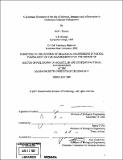A systematic evaluation of the role of infection, immunity and inflammation in cholesterol gallstone pathogenesis
Author(s)
Maurer, Kirk J
DownloadFull printable version (23.43Mb)
Other Contributors
Massachusetts Institute of Technology. Biological Engineering Division.
Advisor
James G. Fox.
Terms of use
Metadata
Show full item recordAbstract
Cholesterol gallstones are exceptionally common and cost nearly 10 billion U.S. dollars annually. Despite a half-century of basic and clinical research questions still remain about cholesterol gallstone pathogenesis. The purpose of the study presented herein is to analyze the roles of infection, and immunity in cholelithogenesis. The first two aims of this work were to analyze the role of enterohepatic Helicobacter spp. and the human gastric pathogen H. pylori in cholesterol gallstone formation. To test this, we prospectively infected C57UJ mice with a variety of Helicobacter spp. and fed infected and uninfected mice a lithogenic diet for eight weeks and analyzed biliary phenotype. Mice infected with H. bilis or coinfected with H. hepaticus and H. rodentium and fed a lithogenic diet developed cholesterol gallstones at 80% prevalence compared with approximately 10% in uninfected controls (P<0.05). Monoinfections with H. hepaticus, H. cinaedi, H. rodentium, and H. pylori gave a cholesterol gallstone prevalence of 40% (P<0.05), 30%, 20% and 20%, respectively; with the exception of H. hepaticus, cholesterol gallstone formation in these groups did not differ significantly from uninfected animals. (cont.) These findings suggest that some Helicobacter spp. play a role in the cholesterol gallstone formation in mice and perhaps humans. We further hypothesized that inflammation and immunity were important in cholesterol gallstone formation and that cholelithogenic bacteria were promoting gallstones through immune stimulation. To test this we utilized BALB/c and isogenic Rag2-/- mice. When fed a lithogenic diet for eight-weeks, wild-type mice developed cholesterol gallstones (27-80% prevalence) significantly more than Rag2-/- mice (~5%, P<0.05). Transfer of functional splenocytes, or T-lymphocytes to Rag2-/- mice markedly increased cholesterol gallstone formation (26% and 40% respectively, P<0.05) whereas transfer of B-cells did not (13%). The presence of T-cells and solid cholesterol monohydrate crystals induced proinflammatory cytokine expression in the gallbladder. These studies indicate that T-cells are critical in murine cholelithogenesis and function by promoting gallbladder inflammation. In summary, these results illustrate that microbial pathogens can influence cholesterol gallstone formation; this most likely occurs by modulating the immune response with T-cells being a critical component in this immunomodulation.
Description
Thesis (Ph. D.)--Massachusetts Institute of Technology, Biological Engineering Division, 2007. Includes bibliographical references.
Date issued
2007Department
Massachusetts Institute of Technology. Department of Biological EngineeringPublisher
Massachusetts Institute of Technology
Keywords
Biological Engineering Division.